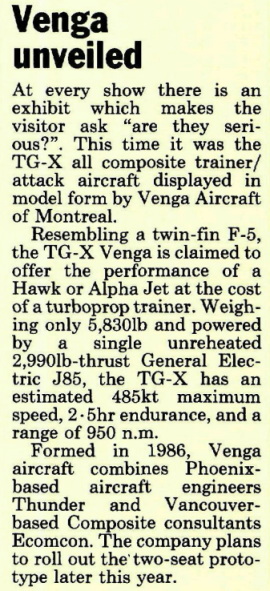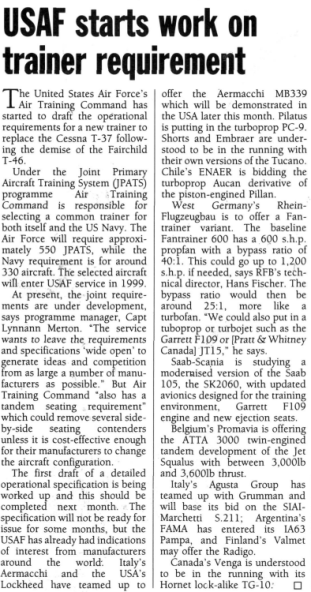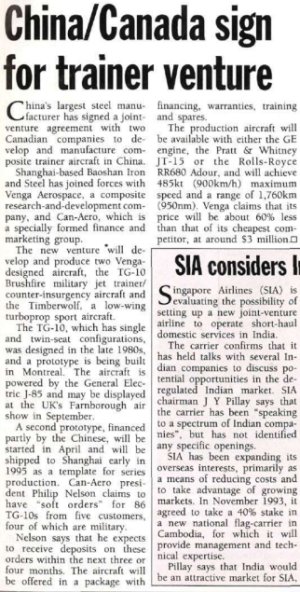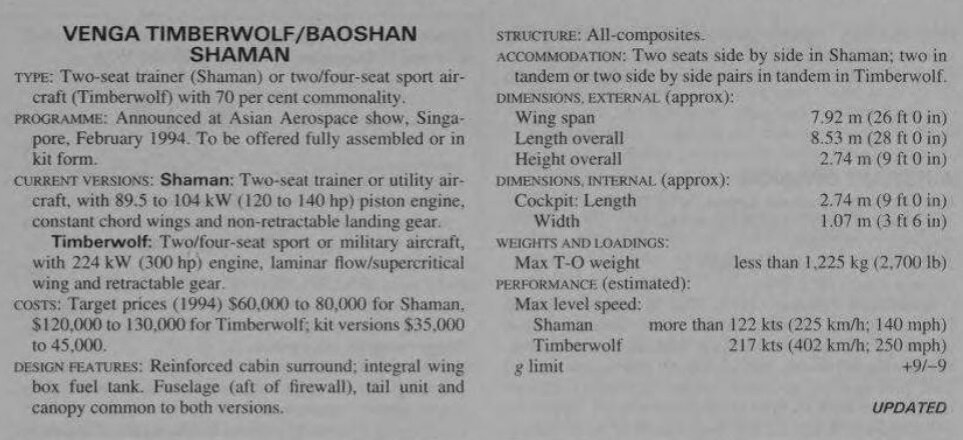VENGA TG-10
An all-composites airframe and modular construction are intended to give the TG-10 an estimated flying life of about 10000 hours, due to a considerable reduction in the corrosion and fatigue problems associated with aircraft of metal construction. Its configuration, broadly similar to that of the Northrop F-5E and McDonnell Douglas F/A-18A, also incorporates low-observables design features intended to improve its survivability. It will be repairable in the field, using replacement major components and quick-change engine modules, and will be operable from roads, grass or unprepared airstrips, with mission capability not only for its primary role as an `all-through' trainer but also, in single-seat form (with the rear cockpit module removed), as a light ground attack aircraft.
Venga reports that it has received letters of interest from five countries, involving approximately 160 aircraft. Rollout of the TG-10 prototype was anticipated in the Summer of 1989, subject to funding availability, and recent joint venture arrangements are claimed to have ensured funding to completion at about that time.
TYPE:
Fully aerobatic two-seat `all-through' jet trainer or single-seat light attack aircraft.
AIRFRAME:
Construction utilises a modular, all-composites structure designed for ease of repair in the field, built from pressure formed foam core laminates bonded together into a single lightweight moulded unit. Materials used are layers of aircraft grade glassfibre cloth bonded to a core of PVC foam (Klegecel or Divinycell) in a vacuum process using various resin matrices. Primary structure built entirely of composites materials, with extensive use of carbonfibre for high stress and other critical areas, though use of carbonfibre reinforced aluminium alloy (eg for main spars) is a customer option.
WINGS:
Cantilever low-wing monoplane, with 2o 30' dihedral from roots. Trailing-edge flaps are operated electrically via Commercial Aircraft Products actuators. Differentially operating ailerons, each with trim tab.
FUSELAGE:
Modular structure (see `Airframe' paragraph), of similar general appearance to Northrop F-5E. Electro-hydraulically actuated airbrake beneath fuselage.
TAIL UNIT:
Low-set, sweptback tailplane with slight anhedral. Twin non-swept, outward canted fins, with inset rudders, forward of horizontal surfaces. Trim tabs in elevator and each rudder.
LANDING GEAR:
Retractable tricycle type, with electro-hydraulic actuation; nosewheel retracts forward, mainwheels inward into fuselage. Wheel sizes 5.00-5 (nose), 6.00-10 (main). Nosewheel
steerable through 30o. Mainwheels have hydraulic brakes and parking brake.
POWER PLANT:
Prototype powered by one 13.01 kN (2925 lb st) General Electric J85-GE-5 turbojet; standard engine for basic production version will be an 11.12 kN (2500 lb st) Pratt & Whitney
Canada JT15D-4C turbofan, but customer options will include General Electric CJ610 or Rolls-Royce Viper 632 or 680 turbojets. Intakes are each fitted with a large splitter plate, and are designed to inhibit foreign object damage. Fuel system, designed to permit fully aerobatic manoeuvres, comprises three fuselage cells with total usable capacity of 1223 litres (323 US gallons; 269 Imp gallons). A 265 litre (70 US gallon; 58 Imp gallon) drop tank can be carried on the fuselage centreline station in the single-seat attack configuration.
ACCOMMODATION:
Standard trainer has tandem accommodation for pupil (in front) and instructor on UPC zero/zero ejection seats under jettisonable bubble canopy, with internal screen between cockpits.
Seats are reclined, adjustable horizontally and vertically, and can accommodate back-type parachutes. Dual controls standard, except for switches for fuel pumps, weapon control panel and parking brake; in lieu of these, rear panel has a full set of indicators for the weapons system, an override switch to prevent firing, and a parking brake indicator. Rail mounted rear seat and rear instrument panel module are easily removable to permit quick conversion to single-seat light attack configuration. Cockpit(s) fully air-conditioned, but not pressurised; latter may be offered later as a customer option.
SYSTEM:
28V DC electrical system, powered by a standard starter/generator and Gates Energy Products lead-acid battery, with second battery for emergency backup. Power sources are coupled to three busbars in front cockpit (main, avionics, and emergency) containing trip-free circuit breakers. NATO type external ground power socket. Normalair-Garrett diluter demand oxygen system, capacity 225 litres (8 cu ft).
AVIONICS AND EQUIPMENT:
Avionics include two VHF com, intercom, VOR/ILS/marker beacon receiver (front), VOR/LOC nav (rear), ADF, transponder, and DME. Full IFR capability, with electrically driven
gyro instruments; main directional gyro is a King slaved type unit. Provision for HUD, radar altimeter, nose radar or other avionics to customer's requirements. Standard cockpit instrumentation and equipment includes ASI (two), VSI (two), encoding altimeter, standard altimeter, clock (two), horizon gyro (two), turn and slip indicator (two), accelerometer (two), angle of attack indicator, pictorial navigation indicator, magnetic compass (two), DME indicator (two), ADF information display (two), first aid kit, IFF transponder, fire extinguishing system, and internal/external lighting.
ARMAMENT:
One centreline and four underwing hardpoints, each stressed for loads of up to 181.5 kg (400 lb), for weapons, fuel tank (centreline only), survival or rescue packs, or other stores,
subject to a max external load of 845 kg (1864 lb) in single-seat attack version. Weapons specified at present include up to three Portsmouth Aviation 7.62 mm FN gun pods with 450 rds/gun; up to three HMP 0.50 in Browning gun pods with 250 rds/gun; two GIAT 20 mm M621 gun pods with 150 rds/gun; various rocket launchers (Matra F2 with six 68 mm, Aerea AL 18-50 with eighteen 2 in, AL 8-70 with eight 2.75 in FFAR, AL 6-80 with six 81 mm, LAU-32 with seven 2.75 in FFAR, SNIA 2 in, Brandt 7 with seven 68 mm, or SURA-D 81 mm); SAMP 32 kg or 50 kg general purpose or 120 kg fragmentation bombs; 11 kg Mk 76 practice bombs; or a 70 mm automatic panoramic IRLS reconnaissance pod.
EXT. DIMENSION:
EXTERNAL:
Wing span.....................................8.23 m (27 ft 0 in)
Wing chord at root.............................2.29 m (7 ft 6 in)
Wing aspect ratio.............................................5.4
Length overall...............................11.89 m (39 ft 0 in)
Fuselage: Max width............................1.42 m (4 ft 8 in)
Height overall................................4.04 m (13 ft 3 in)
Tailplane span................................3.96 m (13 ft 0 in)
Wheel track...................................3.05 m (10 ft 0 in)
AREA:
Wings, gross.................................12.54 m2 (135.0 sq ft)
Trailing-edge flaps (total)....................1.30 m2 (14.0 sq ft)
Rudders (total, incl tabs).....................1.11 m2 (12.0 sq ft)
Tailplane......................................1.67 m2 (18.0 sq ft)
Elevators (total, incl tab)....................1.67 m2 (18.0 sq ft)
WEIGHTS:
(A: two-seat trainer, B: single-seat attack):
Weight empty, equipped (incl unusable fuel):
A.............................................1288 kg (2840 lb)
B.............................................1047 kg (2308 lb)
Max usable internal fuel: A, B...................908 kg (2002 lb)
Max external stores load: A.......................277 kg (610 lb)
B..............................................845 kg (1864 lb)
Max T-O weight: A...............................2645 kg (5832 lb)
B (without external stores)...................2041 kg (4500 lb)
B (with max external stores)..................2886 kg (6364 lb)
PERFORMANCE:
(estimated: prototype with J85 engine at 2645 kg; 5832
lb max T-O weight):
Max level speed:
at S/L, ISA.......................485 knots (899 km/h; 558 mph)
at 9150 m (30000 ft), ISA.........450 knots (834 km/h; 518 mph)
Stalling speed........................78 knots (145 km/h; 90 mph)
Max rate of climb at S/L, ISA................2134 m (7000 ft)/min
Time to 9150 m (30000 ft)..............................7 min 12 s
T-O run at S/L, ISA................................186 m (610 ft)
T-O to 15 m (50 ft) at S/L, ISA...................402 m (1320 ft)
Ground turning radius, all wheels rolling.....6.10 m (20 ft 0 in)
Max range:
internal fuel only, 10% reserves...950 nm (1760 km; 1094 miles)
with c/l drop tank, no reserves...1271 nm (2355 km; 1463 miles)
Max endurance at 9150 m (30000 ft).....................2 h 30 min












